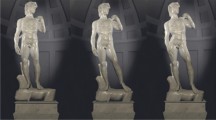Abstract
Head canting, a lateral shift of the head toward the shoulder axis, was examined in 1498 figures in the complete works of 11 painters from the XIV to the XX century: Martini, van Eyck Hubert and Jan, Holbein, Carracci, Velazquez, Rembrandt, Degas, Cèzanne, Klimt, and Modigliani. All figures (up to 9 in any one painting) that were not in complete profile and that were not depicted bowing or shifting their bodies were selected for analysis. Our analysis found a higher frequency (49%) of head canting in paintings than previously reported in naturalistic settings. Head canting was significantly higher in female figures than male figures. If a figure's head was facing laterally, head canting was more likely to be to the contralateral side. Head canting was lower in older figures than in children, youths, and adults. The highest level of head canting was seen in religious and mythological figures. Head canting was lower in figures of artists and professionals and virtually absent in depictions of nobles. Figures in pose were depicted with less head canting than those in natural settings. Head canting was lower in figures gazing toward the observer. Single-figure portraits head canted less than subjects in multiple-figure paintings. Author analysis revealed that head canting was pronounced in painters of religious subjects and in modern painters, whereas its degree was reduced in official portrait painters. These results are discussed in terms of dominance theory.
Similar content being viewed by others
References
Arpino, G. & Lecaldano, P. (1969). L'opera pittorica completa di Rembrandt. Milano: Rizzoli.
Bardi, P.M. (1969). L'opera pittorica completa di Velazquez. Milano: Rizzoli Editore.
Boggs, J.S. (1962). Portraits by Degas. Berkeley: University of California Press.
Brignetti, R. & Faggin, G.T. (1968). L'opera completa dei van Eyck. Milano: Rizzoli.
Coles, P.R. (1974). Profile orientation and social distance in portrait painting. Perception, 3, 303-308.
Contini, G. (1970). L'opera completa di Simone Martini. Milano: Rizzoli.
Cooney, P.J. & Malafarina, G. (1976). L'opera completa di Annibale Carracci. Milano: Rizzoli.
Coss, R.G. (1970). The perceptual aspects of eye-spot pattern and their relevance to gaze behavior. In C. Hutt and S.J. Hutt (Eds.) Behavior studies in psychiatry (pp. 121-147). Oxford: Pergamon Press.
Dixon, A.K. (1998). Ethological strategies for defense in animals and humans: Their role in some psychiatric disorders. British Journal of Medical Psychology, 71, 417-445.
Dobai, J. & Coradeschi, S. (1978). L'opera completa di Klimt. Milano: Rizzoli.
Eibl-Eibesfeldt, I. (1972). Love and hate: The natural history of behavior patterns. New York: Holt.
Eibl-Eibesfeldt, I. (1988). The biological foundation of aesthetics. In I. Rentschler, B. Herzberger, D. Epstein (Eds.) Beauty and the Brain: Biological Aspects of Aesthetics (pp. 29-68). Basel: Birkh¨auser Verlag.
Eibl-Eibesfeldt, I. (1989). Human ethology. New York: Aldine de Gruyter.
Gatto, A. (1979). L'opera completa di C´ezanne. Milano: Rizzoli.
Goffman, E. (1976). Gender advertisements. Studies in the Anthropology of Visual Communication, 3, 69-154.
Goffman, E. (1979). Gender advertisements. New York: Harper & Row.
Halberstadt, A.G. & Saitta, M.B. (1987). Gender, nonverbal behavior, and perceived dominance: A test of the theory. Journal of Personality and Social Psychology, 53, 257-272.
Henley, N.M. (1973). Status and sex: Some touching observations. Bulletin of the Psychonomic Society, 2, 91-93.
Henley, N.M. (1977). Body politics: Power, sex, and nonverbal communications. Englewood Cliffs, NJ: Prentice-Hall.
Kendon, A. & Ferber, A. (1973). A description of some human greetings. In P. Michael & J.H. Crook (Eds.), Comparative ecology and behavior in primates (pp. 591-668). New York: Academic Press.
Key, M.R. (1975). Male/female language. Metuchen, NJ: Scarecrow Press.
Larsen, R.J. & Shackelford, T.K. (1996). Gaze avoidance: Personality and social judgments of people who avoid direct face-to-face contact. Personality and Individual Differences, 21, 907-916.
McClelland, D.C. (1958). The use of measures of human motivation in the study of society. In J.W. Atkinson (Ed.), Motives in fantasy, action, and society: A method of assessment and study (pp. 518-552). Princeton, NJ: Van Nostrand.
Mills, J. (1984). Self-posed behaviors of females and males in photographs. Sex Roles, 10, 633-637.
Morris, D. (1977). Manwatching: A field guide to human behavior. New York: Abrams.
Otta, E., Lira, B.B.P., Delevati, N.M., Cesar, O.P., & Pires, C.S.G. (1994). The effect of smiling and of head tilting on person perception. Journal of Psychology, 128, 323-331.
Piccioni, L. & Ceroni, A. (1970). I dipinti di Modigliani. Milano: Rizzoli.
Previc, F.H. (1994). The relationship between eye dominance and head tilt in humans. Neuropsychologia, 32, 1297-1303.
Purtle, C.J. (1982). The marian paintings of Jan van Eyck. Princeton, NJ: Princeton University Press.
Puyvelde, van L. (1955). Hubert e Jan van Eyck. Roma: Edizioni Mediterranee.
Regan, J.M. (1982). Gender displays in portrait photographs. Sex Roles, 8, 33-43.
Rosa, L.A. (1959). L'espressione dei sentimenti nelle opere d'arte e nel vivo. Bologna: Edizioni Minerva Tecnica.
Salvini, R. & Grohn, H.W. (1971). L'opera completa di Holbein il Giovane. Milano: Rizzoli.
Wilson, A. & Lloyd, B. (1990). Gender vs. power: Self posed behavior revisited. Sex Roles, 23, 91-98.
Author information
Authors and Affiliations
Corresponding author
Rights and permissions
About this article
Cite this article
Costa, M., Menzani, M. & Bitti, P.E.R. Head Canting in Paintings: An Historical Study. Journal of Nonverbal Behavior 25, 63–73 (2001). https://doi.org/10.1023/A:1006737224617
Issue Date:
DOI: https://doi.org/10.1023/A:1006737224617




